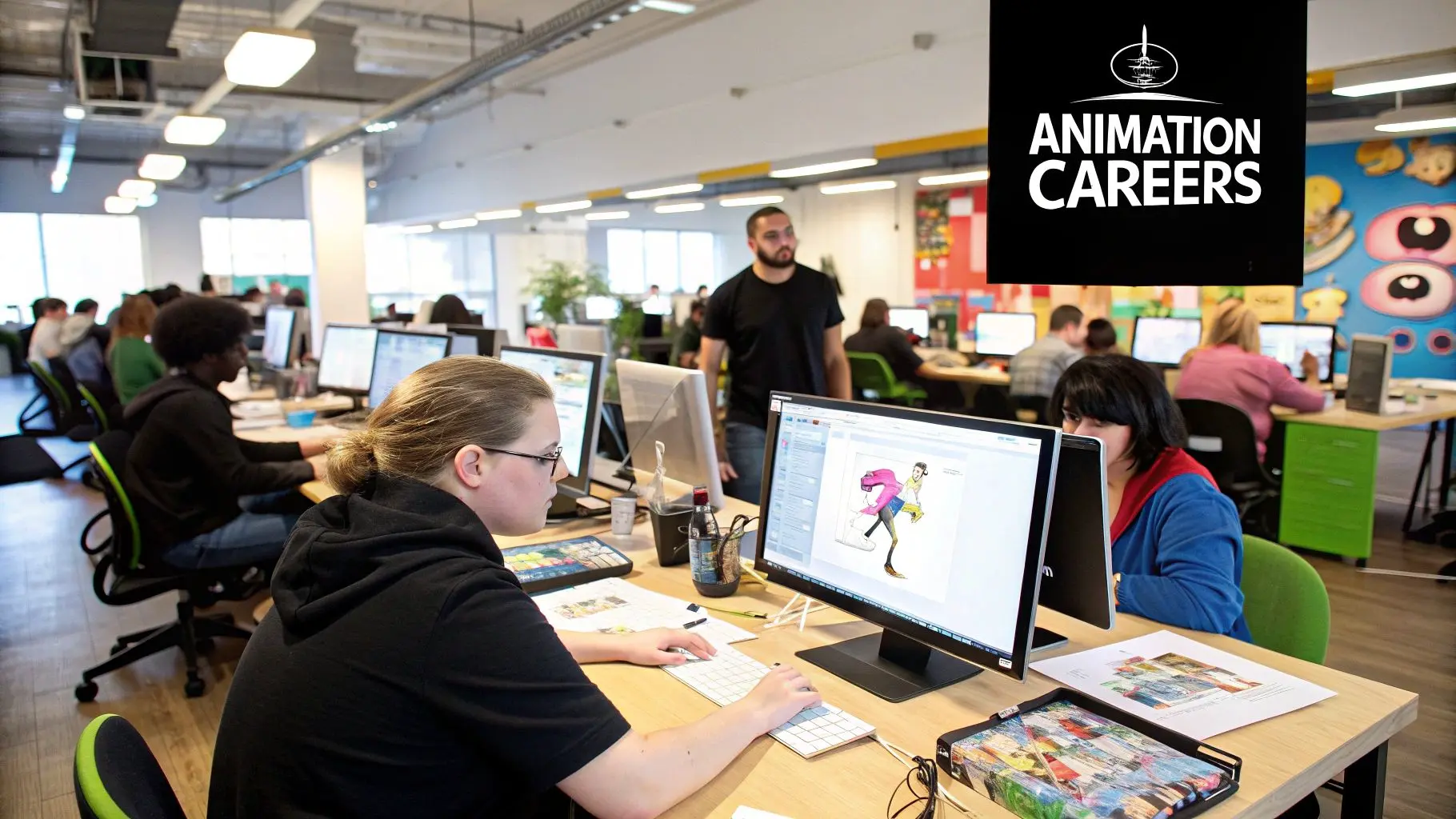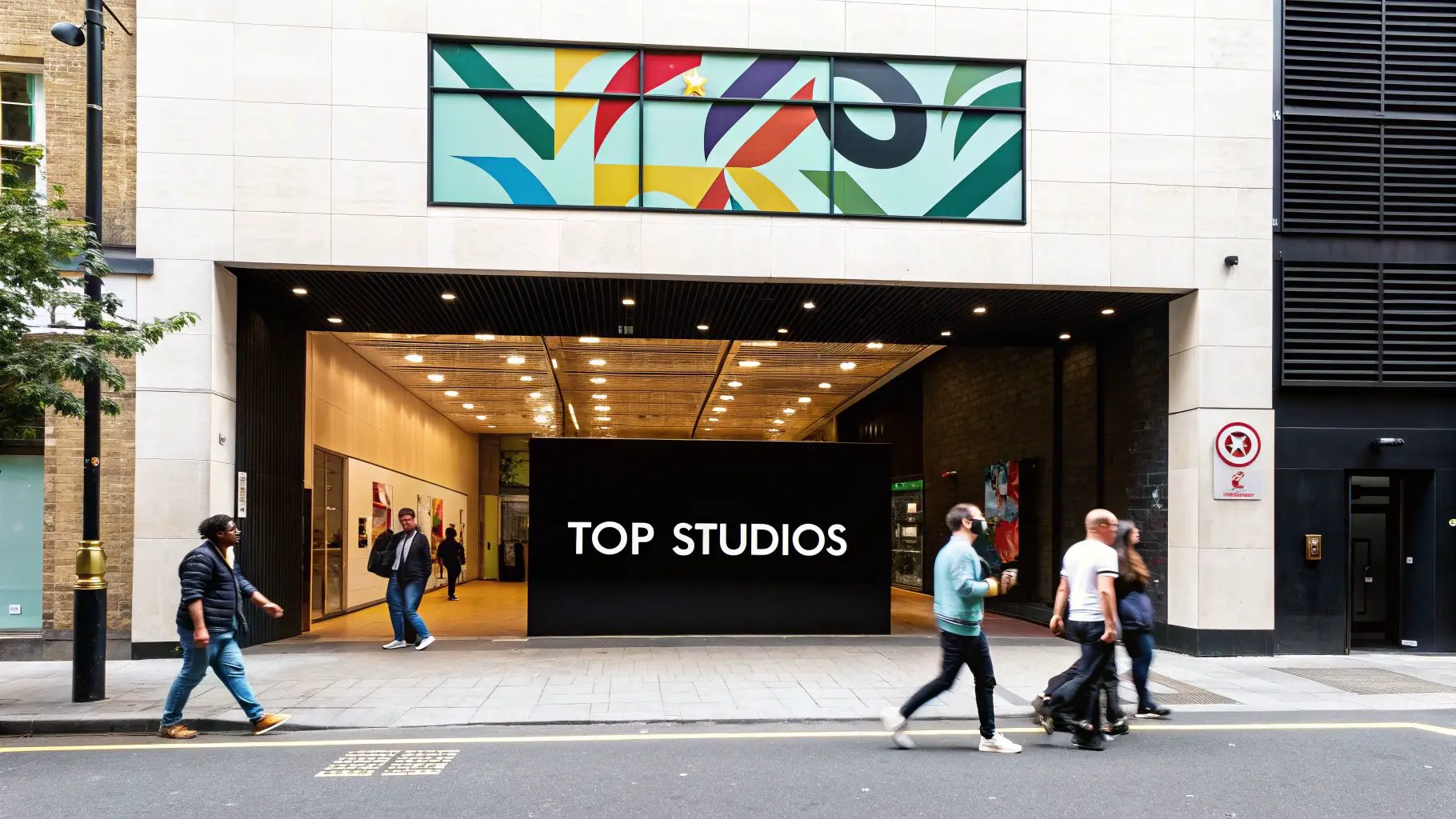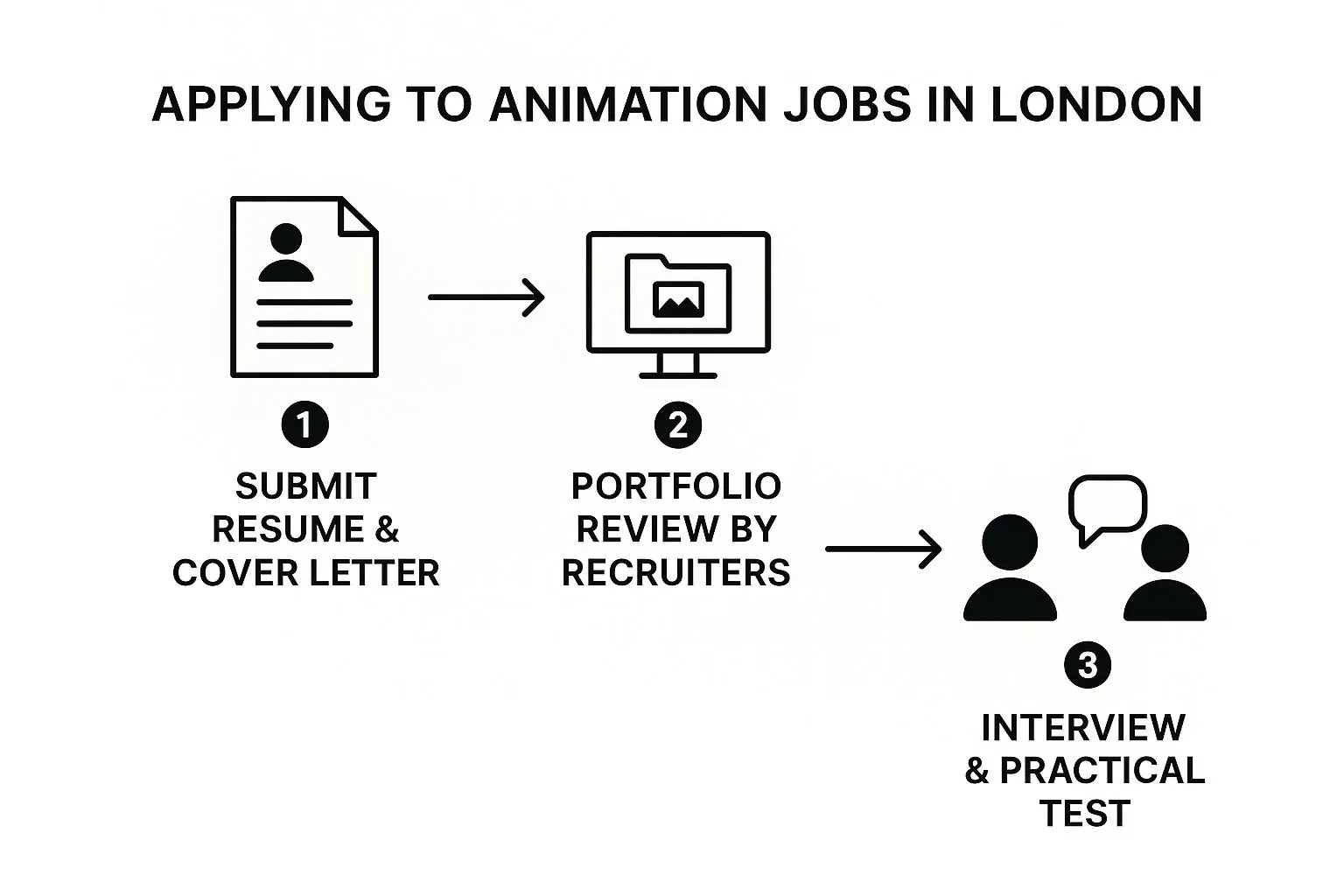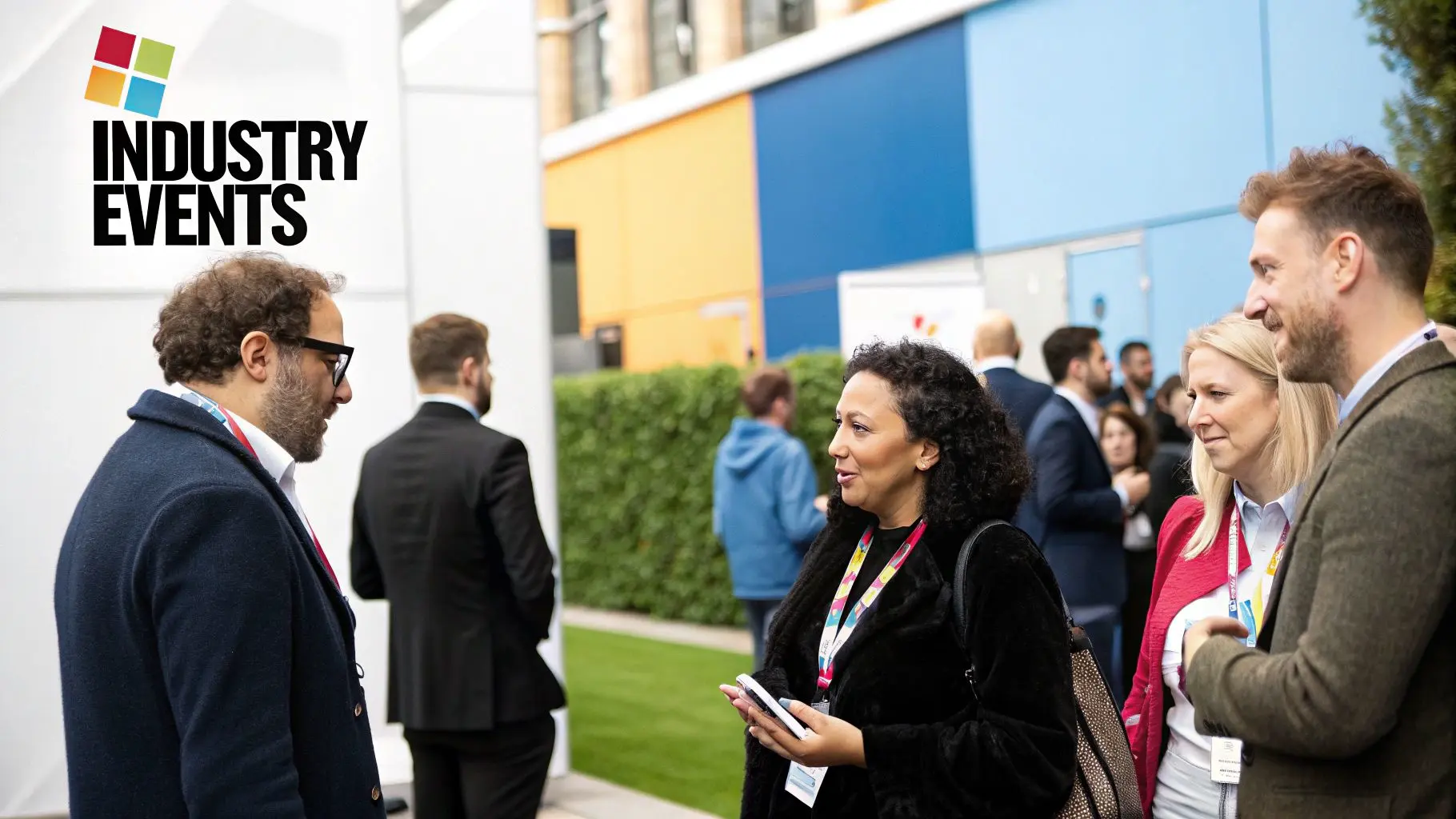Find Animation London Jobs And Build Your Career
Landing an animation job in London is more than just a career move; it's about plugging yourself into a world-renowned creative hub. Even with the usual market ups and downs, the city is an absolute powerhouse for animation and VFX. You’ll find a huge mix of roles here, from classic 2D character work to mind-bending 3D effects for blockbuster films, TV, and advertising.
Understanding the London Animation Scene

London isn't just a big fish in the UK’s creative pond; it’s a global leader. The animation and VFX scene here is a living, breathing ecosystem. You've got the massive, world-famous studios, the super-specialised boutique agencies, and a buzzing freelance community all rubbing shoulders. This creates a competitive, yes, but incredibly opportunity-rich environment for animators, no matter where you are in your career. The sheer density of talent and high-profile projects cements London's top-tier status. It’s still the undisputed king of animation and visual effects (VFX) employment in the UK, and frankly, across Europe. The city is home to thousands of professionals working directly in VFX and animation. This puts London third in the global workforce rankings, right behind Mumbai and Los Angeles. You can dig into these global workforce findings over at Animation UK.
London Animation Job Market at a Glance
To give you a clearer picture, here are some key figures that show the scale and dynamics of London's animation industry. This table offers a quick snapshot of the employment landscape you're looking to enter.
| Metric | Figure |
|---|---|
| Total Animation & VFX Professionals | 10,564 |
| Global Workforce Ranking | 3rd (after Mumbai & LA) |
| European Workforce Ranking | 1st |
| Lead over Nearest EU Rival (Paris) | More than double |
These numbers aren't just statistics; they represent a massive community of artists and a constant flow of exciting projects that you could be a part of.
The Spectrum of Opportunities
When you hear "animation jobs," your mind probably jumps to feature films or kids' TV shows. And while those are massive sectors, the industry in London is so much broader than that. The demand for skilled animators bleeds into all sorts of commercial fields, a trend you can get a better sense of by understanding why so many businesses now need animation services. Here’s a quick rundown of the main areas where you'll find roles:
- •Film & Episodic VFX: This is the high-profile end of the pool, with giants like Framestore and DNEG handling blockbuster films and massive streaming series. Jobs here are often highly specialised, so you might focus purely on character performance, creature animation, or effects simulation.
- •Advertising & Commercials: London's ad world is constantly on the hunt for sharp motion graphics and slick character animation. Studios like The Mill and Nexus Studios churn out award-winning work for global brands, which means fast turnarounds and a serious eye for design are essential.
- •Children’s Media & Television: This is a huge part of the London scene, with countless studios creating content for kids that is seen all over the world. It’s a space that offers steady work for both 2D and 3D animators, and where fantastic storytelling and character performance skills are everything.
- •Gaming & Immersive (XR): With a growing legion of game developers and immersive experience creators setting up shop, this sector is a hotbed for real-time animation skills. If you're comfortable in engines like Unreal or Unity, you'll find plenty to get excited about.
The key takeaway here is that London’s animation job market isn’t one single thing. It’s a collection of connected industries, and each has its own culture, pipeline, and specific skill requirements. Finding success often comes down to figuring out which niche best fits your portfolio and where you want to take your career.
How To Build a Portfolio That London Studios Love
Your portfolio is your golden ticket. Forget your CV for a moment, in animation, your reel does all the talking. It's the single most powerful tool you have for landing a job in London. You have to remember that recruiters and hiring managers are swamped, flicking through dozens, sometimes hundreds, of reels a day. Your mission is to make their decision to call you an easy one. Throw the idea of a "one-size-fits-all" portfolio out the window. It doesn't work. A reel that gets you an interview for a demanding VFX role at DNEG is going to look completely different from one that catches the eye of a character animation director at a kids' media studio. Before you even think about hitting 'export', you need to know exactly who you're targeting. Tailor every single second of that reel to show them the specific skills they're desperate to find.
Quality Over Quantity, Always
Trust me on this: London studios would much rather see 30 seconds of absolutely brilliant, polished work than sit through three minutes of projects that are just okay or, worse, unfinished. Your showreel is a highlight reel. It’s not a dusty archive of everything you’ve ever animated. Lead with your best shot. No exceptions. The first 10-15 seconds are make-or-break, so put your most impressive and relevant piece right at the very beginning. If you're on the fence about a piece, leave it out. One weak shot can plant a seed of doubt that taints the rest of your amazing work.
"Your portfolio is a direct reflection of your professional standards. Every piece should demonstrate not just your technical ability, but also your artistic eye, your problem-solving skills, and your understanding of production pipelines. Show us you're ready to contribute from day one."
Clearly Define Your Contribution
Working on team projects is a huge part of the industry, but don't make the recruiter guess what you did. Be crystal clear about your specific role. A simple, clean title card or a breakdown sheet is perfect for this. For instance, a breakdown should look something like this:
- •Project: "Mech Battle" Cinematic Trailer
- •My Role: Lead Character Animator
- •Responsibilities: Keyframe animation for the pilot character; collaborated on facial performance.
- •Software: Maya, Unreal Engine
This isn't just about listing tasks; it's about showing professionalism and honesty. These are two traits that are massively valued in the highly collaborative studio environments you'll find all over London. To see how professional studios credit their teams and showcase the final outcomes of big collaborations, take a look at our past work.
Show Your Process, Not Just the Final Product
The polished final shot is essential, but giving a quick peek behind the curtain can really make you stand out. A brief breakdown, a wireframe overlay, a slick rigging demonstration, or a layering composite, proves you get the how as well as the what. It shows you're a problem-solver. It tells a hiring manager that you don't just make pretty pictures; you understand the nuts and bolts of how they're constructed. This is especially vital for more technical roles in rigging, lighting, or compositing. Just keep it brief. A quick side-by-side comparison or a simple wipe transition is all you need to make an impact. This little touch helps recruiters visualise how you’d fit into their workflow, which is a massive advantage when you're going for those top animation jobs in London.
Skills You Need and What You Can Expect to Earn

Technical chops get your portfolio through the door, but it’s the soft skills that will truly let you thrive in London’s dynamic studio culture. Sure, you need to be a wizard in Maya or After Effects, but hiring managers are really looking for artists who can take feedback without ego, communicate their ideas clearly, and genuinely enjoy being part of a team. Projects move fast here, and deadlines can be tight. That’s why a proactive, collaborative attitude isn’t just a nice-to-have; it's essential. Think of it like this: animation is a pipeline. A character animator’s work depends on the rigger, the lighter needs to be in sync with the compositing team, and everyone has to be on the same wavelength as the director. When you show you’re a reliable, positive, and communicative person, it tells a studio you’ll slot right into their team without friction. That can be just as impressive as a killer animation piece.
Salary Expectations in London
Right, let's talk money. The UK animation scene is a highly skilled industry with a serious economic footprint. The demand for skilled artists directly influences what you can earn, with the median salary in UK animation sitting at a solid £40,000. In London, salaries tend to break down by experience level:
- •Junior Animator (0-2 years): As a junior, you're looking at a starting range of £25,000 - £32,000. Your main goal is to soak up knowledge, learn the studio’s workflow, and prove you're a reliable pair of hands.
- •Mid-Level Animator (3-6 years): Once you’ve got a few solid years and projects under your belt, your earning potential climbs to £33,000 - £45,000. At this stage, you’ll be handed more complex shots and might even start mentoring the fresh new talent.
- •Senior/Lead Animator (7+ years): For the seasoned pros, salaries typically kick off at £46,000 and can easily push into the £60,000s or even higher, particularly for highly specialised roles in VFX or lead positions.
Remember, these figures are just a guide. Specialised skills, like real-time animation in Unreal Engine or complex creature rigging, can command a much higher price tag. The type of studio also plays a huge part, advertising, film, and TV all have different pay scales. Our deep dive on the differences between 2D and 3D animation can give you more insight into how project scope impacts budgets.
If you’re leaning towards the freelance or contract route in London, you’ll want to get your head around how to manage your finances. Many contractors go through umbrella companies to handle their pay and taxes efficiently. It’s worth exploring umbrella company options for animators to see if it’s the right fit for you. This path gives you more flexibility and often a higher day rate, but it comes with the responsibility of managing your own finances.
Getting to Grips with the Current Animation Scene
Let's be honest: breaking into the London animation scene right now means understanding what you're walking into. It's no secret the entire creative industry has been riding some serious waves lately, and London is right there in the thick of it. A perfect storm of factors, the ripple effects from international industry strikes, some high-profile studio closures, and a generally wobbly economy, has made the job market tougher than usual. I’m not saying this to put you off. Far from it. This is about giving you a clear-eyed view of the landscape so you can navigate it smartly. Job security is a bigger conversation than it used to be, and the rapid-fire developments in AI are making everyone question what skills will be most valuable tomorrow. For any artist trying to find their footing, knowledge is your best defence.
How This Affects Jobs and Pay
These aren't just abstract pressures; they have a real impact on jobs and what you can expect to earn. The industry always has its ups and downs, but recent figures really spell out the current squeeze on artists' finances. While the global VFX and animation workforce saw healthy growth in late 2024, it was quickly followed by a significant drop in the first half of 2025 as major projects wrapped up and new ones were slow to get going. Closer to home, nearly one in five UK animation workers said their pay actually went down in 2024. At the same time, the number of people who got a pay rise fell from 56% to just 45%. If you want to dive deeper into the numbers, the 2024 UK Animation Industry Salary Survey from She Drew That is essential reading.
Facing these economic realities isn't about lowering your ambitions, it's about getting strategic. It means you need to be sharper in your job hunt, more flexible in your expectations, and laser-focused on building a portfolio that screams "I'm worth it."
Building Resilience and Finding Your Way Through
Despite all this turbulence, the UK's creative sector is incredibly tough. It’s not just sitting back and taking the hits; it's adapting. The government's tax relief schemes are still a massive draw for international productions, and there are countless industry-led initiatives working to keep studios afloat and protect the UK’s reputation as a world-class place to make amazing things. So, what does this mean for you, the job seeker? It means doubling down on the things you can control:
- •Skill Up: Don't just be good at your software; master it. Get comfortable with real-time engines like Unreal Engine, as they're becoming central to modern pipelines.
- •Get Connected: Networking isn't just a buzzword. Build real, genuine relationships with people in the London animation community. Go to events, connect online, and be a good human.
- •Find Your Niche: Generalists are great, but specialists are often in higher demand. If you can become the go-to person for something specific and tricky, like character rigging or complex FX, you’ll be in a much stronger position.
Today’s market rewards those who can roll with the punches. If you can show studios you're versatile, understand the pressures of a modern production, and are a great person to have on a team, you’ll always have a competitive edge when it comes to landing the best animation London jobs.
Effective Strategies for Networking and Job Hunting
Finding an open role is one thing, but getting a London studio to actually notice your application? That's a whole different ball game. The key is to ditch the scattergun approach of firing your CV into the void and hoping for the best. To get ahead in a field this competitive, you need a smart, targeted strategy. It’s all about focusing your energy where it counts: on the right platforms, with the right people, and with an application that’s impossible to ignore.
Hunting Where the Studios Are
You can save yourself a lot of time by ignoring the massive, generic job sites. London's animation and VFX studios tend to post their most important roles on industry-specific platforms where they know they’ll find genuine talent. Here’s a look at the platforms you should be checking daily. Think of this as your curated list, saving you from the noise of the bigger job boards.
Top Platforms for Finding Animation Jobs in London
If you want to find the best openings, from the big VFX houses to the smaller, boutique studios, these are the places to live and breathe.
| Platform | Best For | Key Tip |
|---|---|---|
| All levels, from junior to lead artist roles. It’s also unmatched for direct networking with recruiters. | Optimise your profile headline with keywords recruiters are actually searching for, like "3D Animator London" or "VFX Compositor". Follow your target studios and interact with their posts, it keeps you on their radar. | |
| Animation UK | Official industry news, insights, and high-quality job listings posted directly from member studios. | The jobs board here is gold. These are often roles you won’t find anywhere else, coming straight from the source. |
| 3dtotal | A brilliant community hub with a curated jobs board focused squarely on 3D art and animation. | This is a fantastic spot for finding roles at both huge VFX facilities and more specialised, creative studios. |
| Creative Recruitment Agencies | Getting access to unadvertised roles and expert advice from recruiters who live and breathe the London scene. | Build a genuine relationship with a couple of trusted agencies like Escape Studios or Yellow Cat. A good recruiter can become your biggest champion, putting your portfolio directly in front of a hiring manager. |
These platforms aren't just for browsing; they’re for building your presence and understanding the rhythm of the industry.
The Real Power of Networking in London
In a city as tight-knit as London, who you know can often feel just as important as what you can do. Networking isn't about awkwardly handing out business cards anymore. It's about building real relationships with peers, seniors, and the industry veterans you admire.
Your network is your most valuable career asset. A recommendation from a trusted artist or a casual chat at an industry event can often lead to opportunities that were never even advertised publicly.
Industry events are the perfect place for this. Even if you're just starting out, getting yourself to events like the BFX Conference, FMX (even if it means a trip!), or smaller London animation meetups puts you in the same room as the people doing the hiring. Show up with the goal of having interesting conversations, not just asking for a job. Talk about a film you loved, a new piece of software, or their studio’s latest project. Be curious. Be genuine. That’s what people remember.
Nailing the Application Itself
With hundreds of artists applying for a single role, studios often use Applicant Tracking Systems (ATS) to do the first pass on CVs. If your application isn't optimised, a human might never even see it. To get past these digital gatekeepers, you need to tailor your CV and cover letter for every single application.
- •Mirror the Job Description: Scour the job spec for keywords and phrases. If they’re asking for "expertise in Autodesk Maya," make sure that exact phrase is on your CV.
- •Show, Don't Just Tell: Instead of a vague statement like "worked on a team project," get specific. Try something like, "Animated 15 seconds of keyframe character performance for the award-winning short film..." Numbers and results grab attention.
- •Keep It Clean and Simple: Forget the fancy graphics or complex layouts on your CV. A clean, single-column format is far easier for both software and a busy recruiter to scan quickly.
The journey from sending your application to getting an offer usually follows a clear path.

As you can see, the initial application is just the first hurdle. The portfolio review and the art test are where you’ll really get to prove you’ve got the skills they need.
How to Ace the Interview and Secure Your Offer

You’ve made it. Your portfolio landed you the interview, and now it’s time to seal the deal. This is the stage where London hiring managers want to look beyond your reel and get to know you as a creative and a potential team member. They’re looking for your passion, trying to understand your thought process, and figuring out if you’ll click with their studio culture. Getting this far is a huge win, but solid preparation is what gets you over the finish line. Think of it less as an interrogation and more as a conversation to prove you’re the right fit. For a deeper dive, this comprehensive guide on interview preparation is a great resource to build up your confidence.
Presenting Your Work and Yourself
Your portfolio got you through the door, so be ready to talk about it inside and out. Don’t just describe what’s on screen; explain the why behind your choices. London recruiters are keen to hear about the creative puzzles and technical hurdles you overcame.
- •Frame yourself as a problem-solver. Talk about your projects in terms of the challenges you faced. For instance, "The director wanted a more heartfelt performance, so I experimented with micro-expressions and tweaked the timing to really sell the emotion."
- •Show your passion for their studio. Why them, specifically? Mention a project of theirs you admire. This proves you’ve done your research and are genuinely excited about their work, not just any job.
- •Ask intelligent questions. Remember, an interview is a two-way street. Inquire about the team dynamics, the production pipeline, or the creative goals for their current projects. It shows you’re already thinking like a collaborator.
They already know you have the technical chops from your reel. The interview is about discovering if you're a good creative partner. They need someone who can take direction, contribute ideas, and handle the pressure of a real production environment.
Tackling Art Tests and Technical Challenges
Don't be surprised if a practical test is part of the process. Many London studios use them to see how you approach a brief under a bit of pressure. It’s not just about speed; it's about seeing your methodology in action, whether that's animating a short sequence or untangling a tricky rig. If you can, try to think out loud. Explaining your approach and the steps you’re taking gives them a priceless window into your workflow and problem-solving skills. Honestly, that’s often more valuable to them than a perfectly polished result delivered in a tight timeframe.
Navigating the Offer and Negotiation
When that offer finally comes through, take a moment to celebrate, you've earned it! Then, get ready to talk numbers. Negotiation is a completely standard and expected part of the hiring process, so don't be shy. If you have a competing offer or feel the salary doesn't quite match your experience and the market rates, it's perfectly fine to ask for more. State your case calmly and professionally, highlighting your skills and the value you'll bring to the team. A successful negotiation doesn't just get you a better package; it sets a positive tone for your entire time at the studio. You'll start your new animation London job feeling valued and ready to create something amazing. At Studio Liddell, we understand what it takes to build a successful career in animation. Explore our world-class services and see the incredible work our team produces. Learn More About Studio Liddell